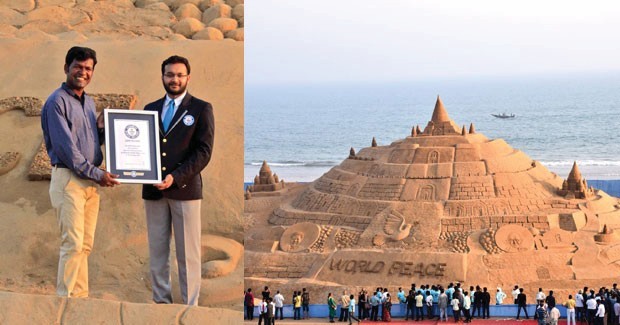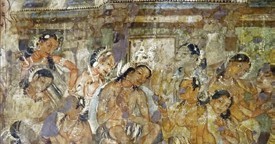Art has time and again been used to narrate stories inspired from the history of a region and its people. More recently, street art and its various forms have been narrating stories that are synonymous with the place and its time in history, the struggles and successes.
India is an ancient land and a melting pot of cultures and influences. India is home to many ancient cities that are a testimony to how far back the history of the land goes. To name a few – Varanasi, Madurai, Ayodhya, Ujjain, Hampi, Patna, Gwalior, Kannauj, Dwarka, Puri and many more.
Cities this old have a lot to offer in terms of stories, anecdotes, legends, experiences, leaders, local heroes, history, etc. Throughout history, across the world, free thinkers have always found a way to express themselves. Sometimes to raise awareness on a social cause, other times to stir up public sentiments, to unite them even to make them remember their heroes and leaders.
Before street art came into vogue as a medium of expression, there were other media such as sculpting, painting, poetry, folklore, songs, dance, drama, etc. Today, cities across India have been witnessing a thriving trend comprising street art and graffiti and it’s only getting bigger. In India, street art, in its various forms, has come a long way marking walls and public spaces with tales of a zone’s past, its legends, history and its very existence.
Commemorating history through sand art
On every occasion of national and historic significance in India, one name has been a common feature across news channels and news portals, renowned sand artist Sudarsan Pattnaik of Odisha, who has never failed to wow his followers with beautiful sand art symbolising important days and people of Indian history.
Most recently, the acclaimed sand artist created a spectacular sand sculpture of Lord Ganesha on Puri beach, on the auspicious occasion of Ganesh Chaturthi. The festival holds tremendous religious and historical significance in Maharashtra and Gujarat. The sand art created by Pattnaik was made by using 3,425 sand laddoos and flowers on the popular beach in Odisha.
However, Ganeshotsav is now celebrated in several other parts of India and has garnered national attention in the recent years. One of the most resplendent and grand festivals celebrated in India, Ganeshotsav has a link to history and India’s independence movement.
Freedom fighter Bal Gangadhar Tilak who is also known as ‘The Father of Indian Unrest’, as described by the British, was the man behind turning a private, household Ganesh Chaturthi celebration to a huge public event. Ganeshotsav is more than a festival of revelry. It holds great significance in Indian history and has deep roots in the country’s tradition and heritage.
Owing to Lokmanya Tilak’s efforts, Ganeshotsav at that became a big mass movement of independence, especially in Maharashtra. The British were terrified of these public celebrations during Ganeshotsav. Later, the Rowlatt Committee report also raised concerns about the festival stating that in Ganeshotsav youth protested against the British on the streets.
History in sand
Sand artist Pattnaik has, for years, used his art to commemorate landmark events of Indian history. For example, when Draupadi Murmu scripted history by becoming the first tribal President of India, Pattnaik created a magnificent sand art on Puri beach to commemorate her and her achievement. Such efforts are a great way of educating masses and spreading awareness.
Earlier this year, Sudarshan paid a rich tribute to former Prime Minister of Japan Shinzo Abe by creating a huge sand portrait of the late leader at Puri beach. He wrote a heartfelt note remembering Abe as a great friend of India.
Last year, the famous sand artist created an eight foot by 13-foot sculpture with seven tonnes of sand on World Environment Day to give a message to the people that people can lead a healthy life in a safe environment. At the time, the United Nations Environment Programme (UNEP) praised the sand art made by Sudarsan Pattnaik on Odisha’s Puri beach to celebrate World Environment Day.
Sudarsan Pattnaik was born in a poor family in Marchikote Lane in Odisha’s Puri district in 1977. In February 2017, he broke the Guinness world record for making the world’s largest sand castle located on Puri Beach, Odisha. He became the first Indian to win the Italian Sand Art Award 2019 at the International Scorrano Sand Nativity event held in Lecce, Italy. He was awarded the Fourth Highest Civilian Award, the Padma Shri by Government of India in 2014 for his contribution in sand arts.
Etching a mark in time
Like Sudarshan, several other artists in India have been using different mediums to depict events from history and to commemorate local heroes and leaders. Among the more recent events in history, it’s India’s freedom struggle that people can relate to today. The fight for independence that lasted for almost a century continues to be demonstrated by artists across India.
This year holds significance being the 75th year of independence and artists have not left any opportunity to make the most of it. The story of India’s freedom struggle and of the unsung freedom fighters and revolutionaries has been told time and again through art.
This year, as part of the Azadi ka Amrit Mahotsav, the ‘hidden’ and ‘less familiar’ aspects of India’s freedom movement, in addition to the well-documented and well-known events shall be on display at an exhibition at The Indian Museum in Kolkata.
The ‘ground-breaking’ initiative is not just intended to be a revision of history but a showcase of how various artists conceive and visualise the nation and its Independence. India’s journey from being a British colony to a global power is not ordinary and the curators intend to capture that through art.
The exhibition ‘March to Freedom’ will feature ‘160 artworks and historical artefacts’ including unknown works by Indian artists, art work by renowned modern artists, unseen photographs, cinema posters, collectible figures, etc.
The artwork in ‘March to Freedom’ is intended to present independent India’s history across eight themes and not in chronological order, as is the case mostly. The themes include Battles for Freedom, The Traffic for Trade, See India, Reclaiming the Past, Exhibit India, From Colonial to National, Shaping the National and Independence.
In India, the practice of painting in public spaces is an old one. Culturally rich country like India has been a fertile bed for many artists and creators who have reciprocated by using art to draw untold stories and legends from history.
It’s a common practice to relive important events in history through art, folklore, etc. Even today, as part of tradition, many tribal community members paint the walls of their homes. Warli artwork is one such form which can be seen across Adivasi homes in Maharashtra’s tribal belt.
The murals in the Buddhist caves in Ajanta in Maharashtra are evidence of how art was used to depict instances and events from history. The caves were accidently discovered in 1819 and date back to the second century BC. Ajanta murals, like many other found across India, have been inspiring artists for centuries. These works are an integral part of Indian history and culture.


 A painting at Ajanta Cave
A painting at Ajanta Cave